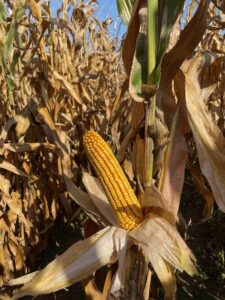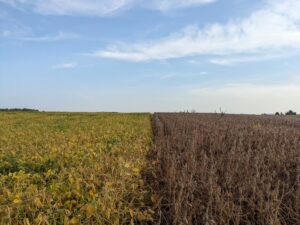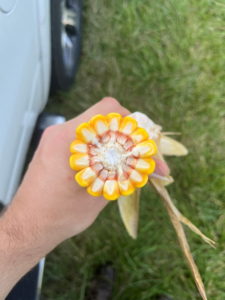Illinois Crop Update – September 20, 2024
Russ Higgins – Commercial Agriculture Educator
Grundy County
Soil Conditions: Severely Dry (soil is very dry, water bodies are very low, vegetation is stressed)
The growing season and grain fill is all but over for most and has ended on a dry note. All fields I have visited have been tinder dry. As harvest gets underway, a reminder to check fire extinguishers, and if available, have a tractor hooked to a tillage implement ready to go to help contain a field fire. Checking combines for residue buildup throughout the day and having the local fire department phone number readily available is also recommended.
Despite tar spot getting a later start in northeast Illinois, by late August and September it spread throughout the upper corn canopy reflected by image provided. Final yields will share the effect tar spot and drought had on the 2024 crop. While checking corn fields I am finding very limited olive-green ear rot symptoms. This can be representative of Penicillium ear rot or Aspergillus ear rot. Aspergillus is most favored by hot and dry conditions. Aspergillus ear rot appears most commonly at the tip of the ear but can be scattered throughout. This ear rot is particularly troublesome because of the fungi’s ability to produce a mycotoxin called aflatoxin. A great resource for identifying and understanding ear rots can be found from the Crop Protection Network.
https://cropprotectionnetwork.org/publications/an-overview-of-ear-rots
Wishing a safe harvest to all!

Figure 1: End of year ear, 18 Sept. 2024

Figure 2: Tar Spot, 18 Sept. 2024

Figure 3: Ear rot
Reagan Tibbs – Commercial Agriculture Educator
Logan County
Soil Conditions: Mildly Dry (soil is drier than normal, plant growth may have slowed)
In the last week, more producers have begun harvesting their crops across Logan, Menard, and Sangamon counties. While there was rain last Friday, it was not enough to slow down the harvest. Many producers seem to be getting their early-planted soybeans out first, with some early-planted corn also coming out. Temperatures in the mid to high 80s have helped crops mature and be ready for harvest. In speaking with producers, corn in drier, sandier soils are below 20% moisture, while most other fields are between 20-25% moisture.
Talon Becker – Commercial Agriculture Specialist
Champaign County
Soil Conditions: Mildly Dry (soil is drier than normal, plant growth may have slowed)
Harvest has begun in select fields in northern Champaign County. A number of corn fields have been “opened up”, and I saw a couple soybean fields where harvest had also started. However, there are still plenty of corn and beans in the county holding on to some green leaves, but the warm, dry weather has been moving things along quickly. Most corn fields surveyed were at or within a few days of R6 (physiological maturity; black layer), although I did find a couple fields still at mid-R5 (dent). Soybeans ranged from late R6 (full seed) through R8 (full maturity) with most falling in the R7 (beginning maturity) range. As is the case in much of the state that didn’t get appreciable rain out of the remnants of last week’s Hurricane (then Tropical Storm) Francine, soil conditions are getting dry in northern Champaign County.

Figure 4: Soybean fields; R8 (full maturity) on the right, borderline R6 (full seed)/R7 (beginning maturity) on the left
Dane Hunter – Commercial Agricultural Specialist
Clinton County
Soil Conditions: Near Normal
The tropical storm blessed most of southern Illinois with somewhere between a quarter or even over an inch of rain, which is especially helpful to the double crop beans still filling their top pods. First crop soybean fields are yellowing but still a ways off from physiological maturity for the most part. Corn is still drying down; most is still not quite to black layer. Lots of silage has been cut in the past couple of weeks. Still not much in the way of harvest occurring in southern Illinois; I’ve only seen one corn field shelled and heard of one soybean field being cut.

Figure 5: The milk line is still lowering on the kernels in a cross section of an ear of corn.





